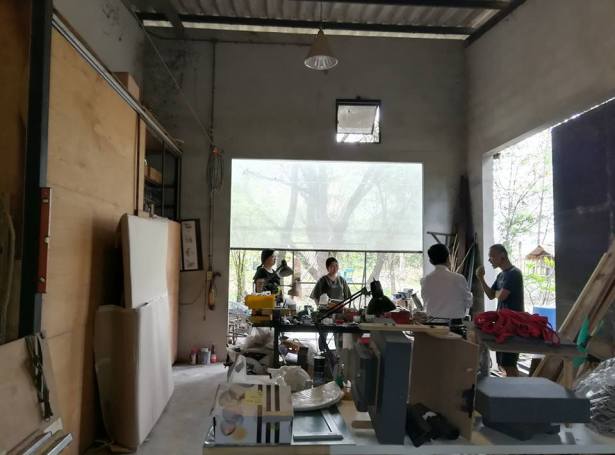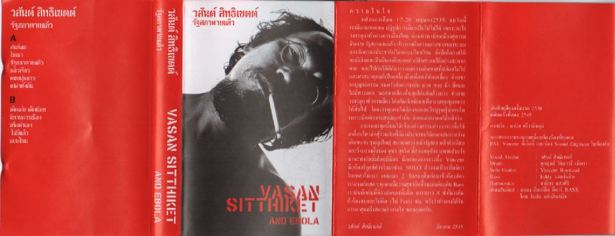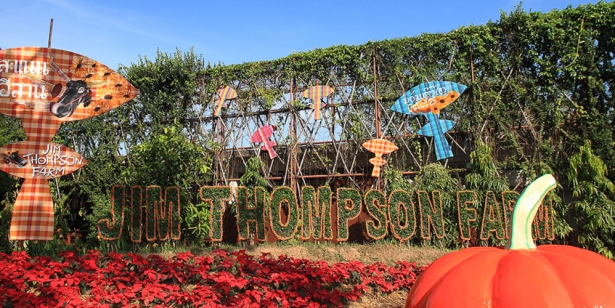This post comes from the Artists and Climate Change Blog
Though metropolitan Bangkok is rapidly pumping out new malls and hotels across its territory, nature conservation organizations and artists have a history of standing together in safeguarding green spaces. They also play a pivotal role in putting other urgent environmental issues on the agenda such as the rising levels of air pollution and animal poaching. Recently, when a black panther was killed in a wildlife sanctuary by one of Thailand’s richest men, artists and activists across the country rose to paint murals, perform music, and demonstrate to make sure this injustice wouldn’t go unnoticed.
Organizations such as the Green World Foundation, the Bird Conservation Society of Thailand, Friends of the River, Society for the Conservation of National Treasures and Environment (SCONTE), and Greenpeace Thailand have been very active and, interestingly enough, have figured out that engaging artists in their work can be extremely effective. In 2017, Greenpeace Thailand organized the exhibition “Heart for the Ocean: Break Free from Plastic†at the Bangkok Art Cultural Center (BACC), which included the installation Blue Ocean, A Message From The Sea by Prasopsuk Lerdviriyapiti, also known as Ajarn Pom. The installation was 3.5 x 5 meters and consisted of seaborne rubbish from several local beaches on the island of Phuket, which Pom picked up along with a crew of seventy volunteers. Phuket, Thailand’s largest island in the South, is known for its beautiful beaches, though in recent years it has been severely impacted by a huge influx of tourists – and their trash.

“Blue Ocean, A Message From The Sea†by Prasopsuk Lerdviriyapiti.
Earlier this year (Jan-Feb 2018), Greenpeace Thailand put on another exhibition at BACC, showcasing the work of Thai artist Ruangsak Anuwatwimon. The exhibition featured a series of sculptures covered in dust that the artist collected from various polluted areas in and around Bangkok, raising awareness about the drastically increased levels of air-pollution in the city. For his project The Ash Heart Project, Anuwatwimon created artworks from the ashes of 270 different species. He collected specimens in his environment that had died due to human involvement, then got the remains ritually cremated and moulded into the shape of the human heart. Cremated species included the Cavendish banana, European olive, fly agaric, a Belgian horse, carp fish, and a house mouse. With this work, Anuwatwimon wants to bring attention to the way humans influence the natural environment, and vice versa. He wants to raise questions about the complex relationship between people, their beliefs, death, and the nature surrounding us.

“The Ash Heart Project†by Ruangsak Anuwatwimon.
In the spirit of compiling my top 10 favorite art/sustainability initiatives in various cities and countries, I attempted to make a selection of 10 art initiatives in Thailand that are doing pioneering work engaging with our natural environment. As I’m more familiar with what’s happening in Bangkok, you will find a lot of city initiatives. But this is only a starting point and I invite you to share more exciting initiatives that you know of in the comments section below!
1. Big Trees
Big Trees is a group of professionals comprised mostly of artists, designers, architects and lawyers. On the weekend, they get together and bike through the city. They visit landmark old trees in parks, Buddhist temples, universities, and diplomatic compounds in order to investigate where development is happening and where they can contribute to preserving nature. They are an active bunch and regularly get out of the city to re-connect with nature, climb mountains and hike together, discussing strategies and campaigns to protect the land in creative ways. This network of art and nature lovers is the go-to place for Bangkokians concerned about trees being cut (which happens a lot), and those who want to get involved with the environmental aspect of art, food, education, crafts, and collaboration.

Big Trees re-connecting with nature and discussing strategies on top of Chiang Dao in the North of Thailand.
2. Bangkok Art and Culture Center (BACC)
It’s incredible but it’s true: This large venue in the heart of Bangkok is the result of a long and persistent campaign of Thai artists advocating for an art center when there was none. Though BACC is now an established art venue, the rebellious spirit of its advocates still shines through its cutting-edge program of exhibitions and events. BACC often hosts shows in collaboration with Greenpeace and never shies away from environmental, political, and social topics.

Green Art Lab Alliance conference at BACC in collaboration with Big Trees.
3. Scrap Lab and RISC
These initiatives by Dr. Singh Intrachooto seem to be only two of the many eco/design/sustainability projects that the well-known architect and designer is involved with. Dr. Intrachooto turned around the Faculty of Architecture at Kasetsart University in Bangkok when he founded Scrap Lab, a design and research center focusing on sustainable materials and material innovation. He uses waste from the food industry and from hospitals (amongst others) that his design students then develop into new products that have new purposes. Expanding on this concept, he also founded the Research, Innovation and Sustainability Center (RISC) earlier this year, where many of these new, sustainable materials are archived and promoted to be used in the industry. From egg-scales to seaweeds, for Dr. Intrachooto creativity is key in making sure nothing is wasted.

The brand new Research, Innovation and Sustainability Center (RISC).
4. Baan Noorg Collaborative Arts and Culture
Based in Thailand’s scenic Ratchaburi province, artists Jiradej and Pornpilai Meemalai collaborate under the name jiandyin. They are also the founders of Baan Noorg Collaborative Art and Culture, a non-profit artist initiative housed in a beautiful old building with a massive garden. They initiate projects with the local Nongpo community and invite artists and researchers from abroad to spend time together in this idyllic place, far away from the city. They operate in a true collaborative spirit, with respect and care for nature as well as for each other.

The Baan Noorg Collaborative Arts and Culture.
5. Rebel Art Space
Rebel Art Space was founded by artists Vasan Sitthiket, Sai Wannaphon Chimbangchong, and Jiratti Kuttunam. The two-floor gallery, tucked away behind the busy Sukhumvit Soi in Bangkok, focuses on art related to acts of rebellion, social activism, and projects that bring attention to societal issues. The topics are especially aligned with Sitthiket’s own work, where demonstration and political engagement are key. Sitthiket even ran for parliament with his Artist Party in 2005. He currently has a solo show on at BACC, another important art institution in Bangkok that he helped establish back in the days.

Vassan Sitthiket at Rebel Art Space.
6. Fabcafe
The Fabcafe is a Makerspace in Bangkok that functions as a central hub for the city’s creative environmental movement. Fabcafe hosts farmers markets and workshops, and offers a variety of digital fabrication tools, including laser cutters and 3D printers. The founders have a background in architecture and are very “networked†with the creative crowd in Bangkok, always ensuring interesting encounters in the cool little cafe that’s part of it.

Bangkok’s Fabcafe.
7. THAILAND CREATIVE & DESIGN CENTER (TCDC)
Now with an additional office in Chiang Mai, the Thailand Creative & Design Center encourages creativity in Thai society with an active program of exhibitions, talks, and workshops. Though it is a large, governmental institution, they have not forgotten about sustainability. Part of the services they offer is a material library for designers, including a beautiful resource library and printing and multimedia tools. They are the initiators of the annual Bangkok Design Week and Chiang Mai Design Week where, particularly in the latter, sustainable materials and crafts such as weaving, natural dying, wood carving and ceramics are well represented.

Chiang Mai Design Week 14 (CMDW14).
8. Land Foundation
Though not recently as active as the Land Foundation, the two famous artists Rirkrit Tiranvanija and Kamin Lertchaiprasert were true pioneers when they established this initiative in 1998, the result of a merging of ideas by different artists to cultivate a place of and for social engagement, located near the village of Sanpatong. Rice farmers in this district of the Chiang Mai province in the north of Thailand were having a hard time due to floods and high water levels. A group of artists suggested to buy the land and revive it in collaboration with the community, and to invite international artists to contribute. They built sustainable artists’ houses and gardens on the site, hosting projects for the local community.

Sample House/Elvis House at the Land Foundation.
9. Creative District Bangkok
Creative District Bangkok is a self-proclaimed “diverse, inclusive, interdependent, and resilient ecosystem†of people (including a lot of artists, designers, and architects) who have as their mission to make the neighborhoods of Bangrak and Klongsan more creative and more green. From organizing river clean-ups and registering trees, to cycling tours to community projects, they are always open to collaboration and creating together. Food (sustainability as well as cuisine innovation), art, community, design, property preservation (a big topic in Bangkok!), and urban planning and environmental improvement are their main points of focus.

Community projects with Creative District Bangkok.
10. Jim Thompson Farm Tour
Jim Thompson was an American who moved to Thailand in the 1950’s and revived the Thai silk industry using new design techniques. He mysteriously disappeared in 1967 and was never found. What remains, however, is the Jim Thompson House, a popular tourist destination in Bangkok. Thompson was a fervent collector of beautiful things, all neatly displayed in his also beautiful house. In the last few years, the Jim Thompson House has expanded its activities, allowing visitors to join on Farm Tour, a cultural “eco and agro†experience. The visit allows people to experience the unique Isan culture (from the North of Thailand) and learn about silk production processes, Thai traditions, and the significance of water. It includes hydroponic vegetable gardens, water gardens, and a huge pumpkin sculpture made of yes, pumpkins.

The Jim Thompson Farm.
With special thanks to Promadhattavedi Chatvichai, Anunta Intra-Aksorn, Singh Intrachooto and Ruangsak Anuwatwimon.
(Top image: The Last Kill painted by 10 Thai muralists, March 2018. Photo:Â Nontarat Phaicharoen/BenarNews.)
______________________________
Curator Yasmine Ostendorf (MA) has worked extensively on international cultural mobility programs and on the topic of art and environment for expert organizations such as Julie’s Bicycle (UK), Bamboo Curtain Studio (TW) Cape Farewell (UK) and Trans Artists (NL). She founded the Green Art Lab Alliance, a network of 35 cultural organizations in Europe and Asia that addresses our social and environmental responsibility, and is the author of the series of guides “Creative Responses to Sustainability.†She is the Head of Nature Research at the Van Eyck Academy (NL), a lab that enables artists to consider nature in relation to ecological and landscape development issues and the initiator of the Van Eyck Food Lab.
Artists and Climate Change is a blog that tracks artistic responses from all disciplines to the problem of climate change. It is both a study about what is being done, and a resource for anyone interested in the subject. Art has the power to reframe the conversation about our environmental crisis so it is inclusive, constructive, and conducive to action. Art can, and should, shape our values and behavior so we are better equipped to face the formidable challenge in front of us.


